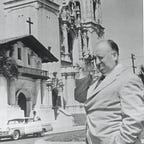Unit 8: A Liturgical Theology of Beholding
In this week’s course reflection question, Dr. O’Malley asked, “What do you find yourself gazing upon? How do these images form you?” In today’s modern world, through the use of the internet on practically any device, one has access to pretty much anything they wish to see. You can be in San Francisco on a device looking at a painting at the Uffizi in Florence and at the same moment one can see something at the Metropolitan Museum of New York Cloisters, all from the comfort of your own bed. We take this completely for granted. Our gaze has now unfortunately become less focused, wondrous and reflective. We are not attuned to what is beyond those images. In Jean Lu Marion’s Crossing of the Visible, “the image becomes for us more than a mode, it becomes a world. The world is made into an image.”(pg.46) The world of chaos is what the twenty-four cable news cycle bombards us with. Because the focus is on the ugly, we fail to pay attention to what is beautiful. Perhaps now that we are ending our COVID 19 isolation, we can take this opportunity to let the images and icons in our world transform us once again to properly gaze, wonder, connect, learn and reflect just as Christians did during the Renaissance. Christian Art for centuries inspired them through icons, statutes, altarpieces, frescoes and paintings and played a vital role in sharing the salvation story. More importantly, it had the ability to transform the heart, which is what is sorely needed in our world today. For this week I will focus on The Ghent Altarpiece, the Adoration of the Mystic Lamb and a fresco by Fra Angelico’s, Saint Dominic Adoring the Crucifixion. I felt most connected to these two pieces and to its message.
Saint Dominic Adoring the Crucifixion Fresco by Fra Angelico scene is so simple, depicting Saint Dominic kneeling at the foot of the cross. The crucified Christ, though in pain, gazed down peacefully on Saint Dominic. I think the piece is extremely moving even though it is extremely sad. The fresco depicts Christ as the ultimate Sacrament and sacrifice. Through Fra Angelico’s use of dissemblance, you can begin to comprehend a little more of what is occurring in this fresco, as it “transit(s) us from the visible to something that is beyond even the intelligible”(Reddaway pg.119) You can see the sadness and disturbance in Saint Dominic’s eyes as he grasps the bottom of the cross. Looking deeper into Christ’s gaze, it is as if Christ is telling him not to be afraid and that He will not abandon him. Death leads to resurrection. The fresco’s placement near the sacristy entrance at the Convent of San Marco is an important and constant reminder that Christ died for us. We might all have crosses to bear, but even in those moments, we are not alone. Christ is always with us. Saint Dominic allowed himself, as Marion writes, “ to be perceived”(Marion pg. 52), to not only gaze at Christ but to also be gazed at by Christ connecting with the divine.
I have been fascinated by Adoration of the Mystic Lamb, the Ghent altarpiece from the very beginning of our course. I noticed it on the course syllabus and have looked at it often. I am very moved by the altarpiece especially after reading Vested Angels by Father McNamee, SJ and then watching Dr. O’Malley’s explanation. I did not realize how large the altarpiece was. The screen dimensions are quite elaborate and involved. Its powerful, rich imagery displays the salvation story. Everyone is converging on to the Lamb on the altar which is at the bottom center panel. It is almost as if it’s a procession, gathering, celebration. It appears as it is a Eucharistic adoration focusing on the Lamb at the center which is also under the dove, the Holy Spirit. The Lamb is the ultimate sacrifice with the altar inscription saying “behold the lamb of God who takes away the sins of the world, Jesus the way, the truth, the life”. Father McNamee, SJ states that the altarpiece “calls attention to the universality of faith in the Eucharist. The saints and the faithful are represented in converging from all four corners of the universe to the Lamb on the altar.”(McNamee pg.115) It speaks to our connection to the divine who unites all people and nations as they are gathered together, gazing and adoring the Lamb, our Lord Jesus.
In conclusion, after reflecting on this week’s unit, I myself was able to recently gaze, ponder and reflect while attending Mass in the Old Mission. The reredos altarpiece in the Old Mission Church, which was designed and built in San Blas, Mexico, was placed in 1794. This baroque piece is impressive because it has had very little restoration work done to it. That particularly day I found myself really beholding Christ on the tabernacle door with his eyes looking up holding the bread, the Eucharist. I found myself really drawn to it and, even though I had seen it so many times, I hadn’t really focused or appreciated the images. This unit awakened that early Christian experience of deep reflection and connection to Christ through images.
